|
Characin Identification 7/5/15
Greetings crew, I hope this email finds you well. I am hoping for help with
identifying a fish that I have obtained. This fish came into my LFS with a
shipment of Peppermint Tetras and I have been trying to properly identify it.
This was the only fish of this species that came in with the shipment.
It is about 3 inches long and swims near the top or the aquarium, and is
somewhat active. I figured that this was most likely some sort of schooling
characin, although it hasn't been nippy or aggressive to the other fish in the
tank (several Loricariids, Pencilfish, red phantom tetras). I am thinking it is
very possibly a Bryconops species, possibly B. magoi, based on the caudal
peduncle shape.
<Does seem a reasonable guess, or else one of the more generic Characidae.
Do note that (so far as I know) all Bryconops have coloured tail fins, typically
with some sort of colouration or marking extending forwards onto the peduncle
and the adipose fin. Yours doesn't, and I can't see an adipose fin at all, which
pretty much rules out most of the characins. Have you access to Characoids of
the World by Gery? It's an old book, late 70s, but useful for this sort of
thing. Do also read:
http://www.mapress.com/zootaxa/2005f/zt01094p023.pdf
This paper includes a key to presently known Bryconops species.>
Unfortunately there are no characin databases or encyclopedias other than
Fishbase that I was able to find for further aid.
<Have you gone through the Fishbase page for a family? For the Characidae, thus:
http://www.fishbase.org/identification/specieslist.php?famcode=102&areacode=
Note that Bryconops belongs to a different family, the Iguanodectidae :
http://www.fishbase.org/identification/specieslist.php?famcode=689&areacode=
If you use the dropdown menus, etc., to add data you know (or might be able to
ascertain) you can narrow these lists down. You can ask where the fish was
imported from (which might be the country it was collected from) and look on
your fish to determine the number of dorsal and anal fin rays. In any case, with
the lack of an adipose fin, you should also consider the
possibility this isn't a characin but a barb or Rasbora.>
Overall coloration is a shiny silver, with a yellowish tint above the lateral
line and some faint yellow tinges to the caudal fin that don't really show up in
these pictures. Any ideas as to what this may be? The fish is doing quite well
but I'd like to know exactly what I have, mystery fish don't sit well with me.
<It isn't obvious to me what this fish is. Perhaps Bob knows? You can at least
predict its needs reasonably well from its shape: open space, reasonable
current, plenty of oxygen, surface feeder, likely jumpy, and of course softish
sort of water chemistry.>
Thank you as always,
CL
<Cheers, Neale.>
|
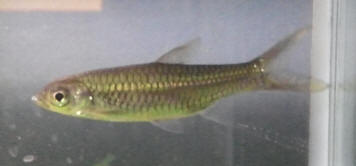 |
|
Fish Identification /BobF
4/6/11
I have six fish in my aquarium that were given to be three years
ago that I would like to identify. I think the person who gave
them to me said they were Rasboras, but it's been so long, I
can't really recall.
<Mmm, not Rasboras; small Characins, tetras... One is a
Hyphessobrycon species... likely a "Serpae" tetra or
related. In the same pic is a Black Emperor Tetra. The last is
Gymnocorymbus... a Black Skirt Tetra>
I have two of each of the three fish in the attached pictures. I
know they aren't the greatest pictures but they were not
complying with my request to be still! All of them are under two
inches, dart around rapidly, get along well, and harassed the
Betta I had in there a while back until I took him out.
I would like to get more fish to go into the tank with them, but
I'm reluctant to do so until I can identify them and make
sure they are compatible with anything else I purchase.
<Good>
They are all in a 40 gallon aquarium in my classroom, so there is
ample room for more fish.
Thank you for your assistance.
Rebecca Coutts
<Welcome. Please peruse the Net, or at least the little bit
that is WWM re Stocking/Selection of these species, their
Compatibility. Other than the Nematobrycon, these tetras are/can
be quite "nippy"... best to keep in small, odd-numbered
groups (5-7... individuals) so they shoal/keep to themselves in
such a sufficiently large volume as you have. Bob Fenner>
Fish Identification /Neale
4/6/11
I have six fish in my aquarium that were given to be three years
ago that I would like to identify. I think the person who gave
them to me said they were Rasboras, but it's been so long, I
can't really recall.
I have two of each of the three fish in the attached pictures. I
know they aren't the greatest pictures but they were not
complying with my request to be still! All of them are under two
inches, dart around rapidly, get along well, and harassed the
Betta I had in there a while back until I took him out.
I would like to get more fish to go into the tank with them, but
I'm reluctant to do so until I can identify them and make
sure they are compatible with anything else I purchase. They are
all in a 40 gallon aquarium in my classroom, so there is ample
room for more fish.
Thank you for your assistance.
Rebecca Coutts
<The purplish one with the black longitudinal stripe is an
Emperor Tetra. The grey, disc-shaped one with the vertical bands
is a Black Widow (or Petticoat) Tetra, a species that is
sometimes nippy, so be careful. The reddish one is a
Hyphessobrycon species of some sort, perhaps one of the very
nippy Serpae Tetra variety, Hyphessobrycon callistus, though it
does remind me of a less common species, Hyphessobrycon pando.
All the Hyphessobrycon species have the potentially to be quite
nippy, so look out for damaged fins, and don't combine with
Angels, Gouramis, Guppies, etc. (or at least be prepared to
remove them if needs be). All these tetras are South American
fish and will do best in soft to moderately hard, acidic to
slightly basic water at a middling temperature; 2-15 degrees dH,
pH 6-7.5, 24-26 C/75-79 F. Cheers, Neale.>
|
|
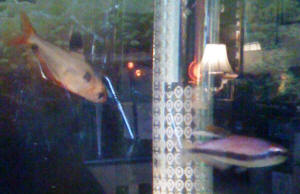 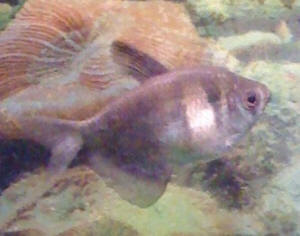
|
|
What is it ? 11/27/09
Hi guys,
<Lesley... you've sent this post three times here, each w/
more than 10 megs of pix... We ask that folks limit these files
to a few hundred Kbytes....>
Lesley from Scotland here, its been a while since I was in touch,
my planted community tank now nearly 4yrs is doing great!
My daughter has a small tank now and we purchased some
Endler's. I have a male in my community tank and one in my
daughters along with what I thought was a female. They are very
hard to come a cross the females and I thought what a stroke of
luck that this wee female was swimming around with all the males
so we took her home.
After looking on line she looks a bit different to the ones that
I have seen on the web she is dark in colour with a neon red
speckle on the rear end of her body, is she an Endler's? Sorry for
the bad photos but she is such a flighty little fish.
Thanks
Lesley
<These images are too blurry to be of any use. Bob
Fenner>
|
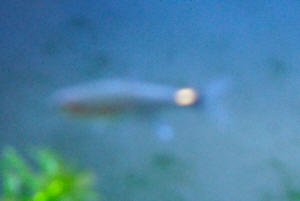 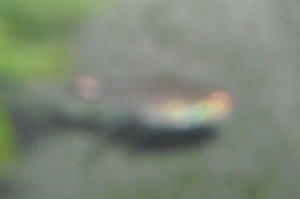 |
what is it,
Characiform 11/28/09
Lesley from Scotland here again,
Sorry about the influx of repeated mails, anyway I have taken a
better picture. Can you help identify this wee fishy, she was
swimming around in our local garden centre with a whole load of
male Endler's. I assumed she was a female, but she looks a lot
different to the pictures on the net.
Thanks for all your assistance once again.
Lesley
<Hello Lesley. The fish looks to be Hemigrammus hyanuary, or
something very similar. Small, harmless schooling fish from South
America; adaptable, but don't keep in hard water. Now, please
do note that *again* you sent along big photos, 5 MB in total. Our
e-mail server bounces back e-mail once the
account reaches 10 MB in total, and that means that messages like
yours can cause other peoples' messages to be bounced back to
them. That's clearly not fair. We do very explicitly ask for
photos around 500 KB in size. If that means you have to set aside
another 10 seconds from your life to resize the image in iPhoto or
whatever, consider that the "coin of the realm" around
these parts. Actually, what it's about is politeness: it's
what we ask, and it's what we need to be able to help everyone,
not just those people who don't care to read the rules. Hope
that this clarifies things. Cheers, Neale.> |
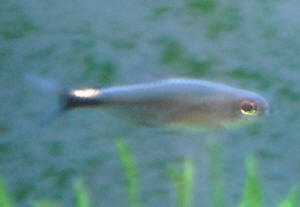 |
Are there such a thing as Serpae tetra
subspecies? 05/25/09
Hi all,
Firstly thanks for all the help with the SAP, plus the website is
amazing! I just picked up another Serpae tetra today (I
miscounted the last time and
only had 11) so the total is now up to 12. This new tetra looks
identical to the other 11 tetras in the school--except s/he is lacking
the black dot located behind the eye. At first I thought it was
stress-related but the fish has adapted well and is eating... but no
spot. Is there such a thing as subspecies?
<The "subspecies" concept does indeed exist, humans for
example being a subspecies of Homo sapiens, Homo sapiens compared with
Neanderthal Man, Homo sapiens neanderthalensis.>
The 11 Serpaes look like this:
http://badmanstropicalfish.com/stats/characins_stats/stats_characins2e.html
And the new Serpae looks like this:
http://badmanstropicalfish.com/profiles/profile75_comment.html
Thanks
<The problem here is that what the industry calls "Serpae
Tetras" can be any one of multiple closely related species in the
genus Hyphessobrycon.
While Hyphessobrycon eques is probably the most commonly traded member
of the Serpae Tetra Species Complex, other species of Hyphessobrycon
may be traded periodically as well. Even within Hyphessobrycon eques
there is substantial variation between geographical populations, and
artificial varieties further muddy the waters. The absence of the black
spot above the shoulder (called a humeral spot) could easily be
explained by any of these reasons. This variation has probably meant
that what people report when keeping "Serpae Tetras" has been
very variable over the years. True Serpae Tetras -- Hyphessobrycon
eques -- are noted for being aggressive feeders and have a feeding
frenzy behaviour very similar to that of large, predatory characins
such as Piranhas and Exodon paradoxus. They are also distinctly nippy,
and will take bites at slow-moving fish such as Corydoras, Platies,
Angelfish, Guppies and so on. Personally, I do not recommend them as
community fish at all. In fact they were my first ever tropical fish,
and the species with which I learned not to trust without verification
anything the pet show owner said! After I added some Angelfish and
Gouramis to my tank, I was shocked to see the carnage, and from that
point onwards have been much more critical about the information
casually
|
ID help please-- 02/28/09 Hello WWM Crew, The
other day, I found these "Emperor Tetras" at a LFS. I
have found only two pictures of them online, under the name Black
Emperor Tetra. Can you tell me anything about these guys? I
suspect they are Nematobrycon amphiloxus, but I cannot find
definitive info about this. Can you confirm this? Do these guys
get large like the typical emperors or stay small like kerris?
Are these rare or new in the hobby? Any help appreciated, I have
five in a planted tank and have attached pictures (sorry, kind of
blurry). Thanks, J.P. <Greetings. Your fish is indeed the
species traded as Nematobrycon amphiloxus, or the Black Emperor
Tetra. However, Nematobrycon amphiloxus is considered to be a
junior synonym of Nematobrycon palmeri by ichthyologists, meaning
the two fish are one and the same thing. So any information that
applies to the one applies to the other. At best, Nematobrycon
amphiloxus is a colour morph of Nematobrycon palmeri. In any
case, Emperor Tetras are fairly easy fish to maintain. They
aren't that fussy about water chemistry, though very hard,
very basic water should be avoided. Anything around pH 6-7.5,
5-20 degrees dH suits them well. They do need soft, acidic water
for breeding though. Emperor Tetras are odd beasts in that they
don't really form schools though they should be kept in
groups. Males hold short-term territories around plants and shoo
off other males. Females are gregarious. I always think
they're a bit like teenagers at a disco, with the girls in a
group, and the males each trying to attract one of to his corner
of the room! Do try and keep more females than males so you can
observe their behaviour whilst avoiding bullying. Anyway,
they're good fish for planted communities, but because
they're quite large (up to 6 cm) and infamously greedy fish,
you do need to watch water quality. They're omnivores and
appreciate some green foods (e.g., cooked spinach and squished
tinned peas) in their diet. Generally nice fish; enjoy!
Neale.>
|
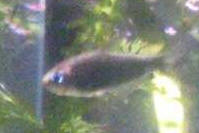 |
|
Re: ID help please 3/1/09 Neale,
Well I have 2 females and 3 males. I initially bought three and
went back for the whole school, but only two remained. Mine seem
to school at times, which is odd because I have kept Emperors for
years and they never acted in that manner. They are really nice
looking little fish. Thanks for the info! -Jayson <Likely
schooling at the moment because they're juveniles or outside
of the breeding season. Once settled and grown up, the males will
become more territorial, so watch for any signs of nippiness
between them. Great fish, and I'm sure you'll enjoy them.
Be sure and feed a mixed diet for optimum colouration! Not just
flake! Cheers, Neale.>
|
|
Fish identification help
2/25/09 Hello! I wonder if you can help me out. I have
collected around 15 fish from a lady who was moving house and
looking for someone to take her fish and re-home them.. however
she was a bit vague about what she had. Whilst I recognize the
upside -down catfish she gave me, plus the red-tailed black shark
and the Puntius pentazona, I am not sure about the 'various
tetras'. I have some pictures - could you possibly help me
out and advise what I have been given?! <Fish 1 is the Diamond
Tetra (Moenkhausia pittieri). A nice community fish; generally
does well so long as the water isn't too hard. Fish 2 is the
Colombian Tetra (Hyphessobrycon colombianus), a semi-aggressive
species prone to fin-nipping but otherwise a good choice for
robust community tanks. Fish 3 is one of the Rosy Tetra group,
possibly Hyphessobrycon rosaceus but there are a bunch of
similar-looking species such as the Bleeding Heart Hyphessobrycon
erythrostigma and the Ornate Tetra Hyphessobrycon bentosi.
They're all fairly good community fish, though a trifle
boisterous. Fish 4 is some type of Hyphessobrycon, but to be
honest I can't really tell from the photo which one.> I
need to be sure these guys will be happy in with my current set
up of Platies, Danios, Puntius pentazona, bristle nose Ancistrus,
Trichogaster leeri and Crossocheilus Siamese (sorry for spelling,
true SAE) in a 180ltr tank. I am fairly sure the red-tailed black
shark will be finding alternative accommodation, as he will not
get on with my SAE's I understand. <Indeed.> Also, one
fish has a cloudy eye (fish 4). He seems fine, there is no sign
of bulging or similar, and is eating well. I do not know his
history of course, but I am treating him with caution! He is the
fish which is whiter than the others and smaller in the picture.
All are currently in my 'spare' 60ltr tank whilst I
assess what to do with them. <Likely physical damage related
to netting, transport. Should heal by itself if water quality is
good. Treating with an anti-Finrot medication will help.>
Thank you!
<Cheers, Neale.>
|
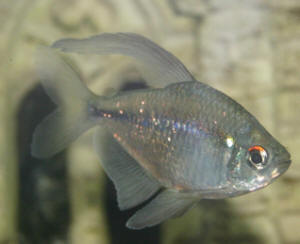 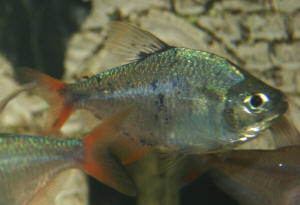 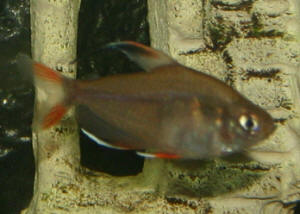 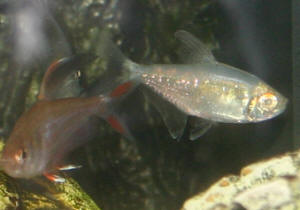 |
| Re: fish identification help 2/25/09 Thank you
so much, I had tried looking them up but scrolling through the
types of tetras made me realize how very many there are! You are a
walking encyclopedia of fish info Neale! Thanks Sarah <What can
I say. A misspent youth. Other boys learned to do useful things
like smoke, make out with girls, and dancing. Me, I learned how to
tell tetras apart. Cheers, Neale.><<A good trade.
RMF>> |
|
Tetra question, ID 8/24/08 Hello
guys! I bought some really pretty Tetra's today; Pristellas
and some that I can't remember the name! I called the
aquarium shop, but they were too busy to go look for me.
<?> They look very similar in color to Pristellas, but
instead of yellow, white and black on the fin, they have
orange/red, white and black on the fin, and they are a little bit
rounder in shape. Very similar to a Serpae Tetra, but the same
color in body to the Pristella. Sort of like a Bleeding Heart,
but without the red heart spot! Haha.....so, can you please help
me identify my cute new friends? Thanks, Anne <Mmm, not from
this description (perhaps a photo...). Do try placing these words
one at time in your search tool: Hyphessobrycon, Pristella... and
select "Photos"... do you see your fish? Bob
Fenner>
Re: Tetra Question -08/24/08 I have one picture, but
it's not very good. I have tried to search online for two
days, and can't figure out what the fish is. If all else
fails, I'll go back to Dallas North and look for myself. What
do you think? Thanks again! <... I think you should re-read
the first corr. and look... it's there. B>
|
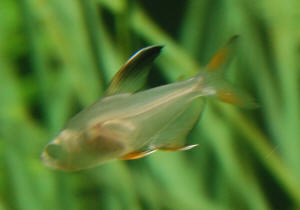 Hyphessobrycon bentosi? Hyphessobrycon bentosi? |
Difference between FW fish
species... 2/24/08 Hi! I just wanted to know what
is the difference between an albino Buenos Aires tetra and an albino
tinfoil barb. They look so alike and I want to make sure my LFS
didn't give me the wrong fish. Thanks <This is easy. Buenos
Aires tetras (Hemigrammus anisitsi) have an adipose fin, whereas
Tinfoil barbs (Barbonymus schwanenfeldii) do not. Cheers,
Neale.>
| Re: Mystery fish! 12/30/07 Thank you so much
for your suggestions. I've searched Fishbase, but so far
haven't come up with a match. I was, however, successful in
getting a couple of half-decent photos now that he seems more
comfortable in the tank, and I'm attaching them here. It's
a dark tank, so the quality isn't what it could be, but you can
identify the number, shape, and placement of all fins if you look
hard (they're unpigmented), see the markings (the upper band of
black is more a trick of the lighting), and the mouth shape.
Perhaps someone will see the picture and say "oh, of
course!" <For what it's worth, I have no idea what this
fish is. I'm a bit confused by the anal fin/pelvic fin
arrangement. If it's a gonopodium, then it is most probably a
Poeciliidae of some sort; Goodeidae tend to have less well
developed gonopodia. But at first glance the fish looked like some
sort of Characidium or perhaps some sort of Cyprinidae. The problem
with the Cyprinidae is that there are literally thousands of
species there, and many are elongate, small, and have a black bar
along the midline of the flank. Does he have an adipose fin? Is
there a gap between the pelvic fins and the anal fin? Is the mouth
equipped with teeth or not? Cheers, Neale.> |
|
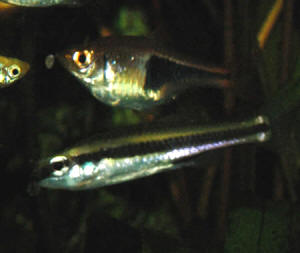
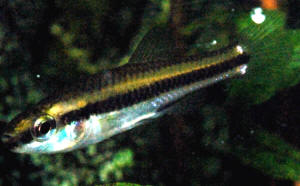
Characidium my guess. RMF
|
| Can you identify this for me 10/14/07 I am
curious to know what kind of fish this is. I found it on the web,
but so far haven't found out what it is... Thanks so much!
Tamara <Tamara, would be happy too... but you sent no photo or
link to photo on the web. Try again, and we'll give it the old
college try! Cheers, Neale.> Re: can you identify this for me my
apologies, I guess I didn't click the attach button...here it
is again. Thanks!! Tamara <Greetings. That's an Emperor
Tetra, Nematobrycon palmeri. And yes, they do look like that... but
only when mature, and only in well-maintained tanks with a dark
substrate and lots of plants. Ideally, with blackwater extract
added or peat granulate in the filter. Too often they are kept in
generic aquaria with plain gravel and not enough plants, and in
response their colours become much more subdued (this is actually
very, very common with freshwater fish, and one reason people
*think* freshwater fish are less colourful than marines). So, you
need a tank with lots of plants to produce shade, black sand
(non-calcareous of course), good water quality, and water chemistry
around 6.0-7.5, low to moderate hardness. As with any other fish,
they get the best colours when well cared for, and that includes a
nice varied diet including both meaty (bloodworms, daphnia, etc.)
and green (algae-based flake) foods. The males are quite feisty, so
keep a good size group with more females than males if you can. Six
would be a good start, but ten would be better. (People often just
buy males of these and other fish, but paradoxically this does
nothing to enhance the look of the tank: You need enough males that
they all "colour up" while displaying to one another, but
also enough females that the males get "in the mood" in
the first place, and also enough females that aggression between
males is diluted throughout the school.) Colour also depends on
what lighting you use: blue lights (like Tritons) will accentuate
the blue colours on the fish, while purple lights (like Gro Lux)
bring out the red/purple shades. So a mix of lamps in the hood
would be ideal. Lovely, lovely fish, though often underrated when
seen in bare, brightly-lit tanks at the shops. There's a
look-alike species called Inpaichthys kerri, sometimes sold as the
Emperor, but among aquarists better known as the Blue Tetra. As its
name suggests, it is more blue than purple, but otherwise the two
species are very much alike in requirements and habits. Both are
excellent community fish. Cheers, Neale> |
|
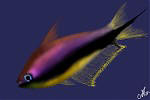
|
Tetra ID How can I identify
tetra. I've tried to find out but found
nothing. It's important. <browse through our
archives at www.wetwebmedia.com to find your fish or a similar fish.
Take note of similar genera and then carry them over to http://www.fishbase.org to search a huge
database for the species you seek. Best regards, Anthony>
Mystery Tetra - 08/04/2005 Hello, <Hi,
Lynn! Sabrina sleuthing with you today....> You guys seem
to be my last hope. I've been to Fishbase, Googled the
web and searched your site extensively. I found a fish when
I was at one of the local Fish stores, and I decided to come home and
research the fish first. There was nothing on the tank other
than the common name, and all the fish people were up to their elbows
in questions. The name of the fish is the Similan
Tetra. On the tank was a note saying that although they look
like Neons and cardinals, they are not the same fish. I
assumed I would be able to track the fish down on Fishbase, so I
didn't bother any of the fish store employees to get the Latin name
(last time I do that). <Can you describe this fish in
detail? I'm familiar with a great many tetras, and
I've got a few friends that are tetra freaks, so among us, perhaps
we can figure this out.> I would really appreciate any help you may
be able to give me identifying what the Latin name is so I can do more
research before I try to add it to my stocking list for my brand new
Tetra tank. The fish store is 2 hours away, so I can't
just run over there and ask. My tank is cycled and my
quarantine tank will be up this weekend (sponge filter in the main,
cycled tank) all per the guidelines y'all have on your website.
<Excellent!> You guys are my only hope on identifying this
Tetra! I've delayed stocking any fish for the last week
while I tried to track down this fish. Thank you for any
help you might be able to give me with this question. <None, without
a very detailed description.... If you write back, put my
name in the subject line.> ~Lynn <Wishing you
well, -Sabrina>
Mystery Tetra - II - 08/07/2005 Sabrina, <Hello again,
Lynn!> Sorry for not describing the fish. It looked like
a neon tetra, but with Blue and Green stripes (kind of blended
together) instead of the red and blue. The ones they had
were between a tank on Neons on the left and cardinals on the
right. I don't know the ages of the fish, but the Neons
were smaller and the cardinals were bigger than the
Similans. The Similans were under an inch long maybe .75
inches or so. Other than that, they pretty much looked like
neon tetras with green & blue bodies. <Mm, a number
of possibilities, here; take a look at Paracheirodon simulans, the
"green neon" tetra - http://www.fishbase.org/Summary/speciesSummary.php?ID=12394&genusname=Paracheirodon&speciesname=simulans
. Also Boehlkea fredcochui - http://www.fishbase.org/Summary/speciesSummary.php?ID=12341&genusname=Boehlkea&speciesname=fredcochui
. Be sure to do google image searches on the Latin
names. P. simulans' species name does indeed suggest it
might be a match.> If I can figure out what this little guy is, and
if he is compatible, I would like to house him in a 55 gal planted
tank. I'm thinking about stocking Clown loaches (3 for
snail control), <Any chance you would consider a smaller species of
loach? I find that Botia striata are one of the most
efficient snail eaters I've ever met - and they top out around a
couple inches. Clowns are slow growers, but I've seen
'em well over a foot in length. Just something to
consider.> Otos (6 - start with 8 with one or two heading over to
the Beta Tank when it starts looking green), Corys (4- start with 7
because 3 will move over to the Betta tank in a month or two) false
rummy-nose tetras (8), black neon tetras (8), neon tetras (8), and
maybe these little green/blue mystery guys (8). <To be
quite honest, I would assume these mystery fish are quite compatible
and have similar care requirements. P. simulans should be a
fine addition, if that is what they are. Worst case
scenario? Take 'em back to the store if they don't
work out. I normally do NOT advocate purchasing something
you know next-to-nothing about, but when faced with a brand new fish
I've never, ever seen in stores before, I often will start
rearranging tanks so I'll have a quarantine for them. ;) >
Thanks Sabrina for your help! <You bet! Wishing you
well, -Sabrina>
Freshwater fish identifications, ChuckR Hi there I need to
identify two fish to find out more about them. The one was called a
"black widow" in the shop I bought it from. Its shape is very
similar to a silver dollar. It is mostly black on the top half of its
body and the tail is silver. Apprx 2cm long. I've looked everywhere
for information on this fish but can not get anything, except black
widow tetra, which I do not think it is. (saw a picture somewhere) <
The black skirt tetra is sometimes called the black widow tetra. If
this is not your fish then you will need to provide more info like a
photo.> The other fish is definitely a goby, no doubt about that. It
is white with black spots, and a small black "stripe" at the
back of its top fin. The sizes are apprx 3 & 5cm each. The shop
owner said its a spotted goby and that the female is the bigger one of
the two, but alas, I can find no information/pictures on what it
actually is. It is a very shay fish. <Look at photos of the knight
goby (Stigmatogobius sadanundio ). Males have longer fins.> Both are
freshwater fish. I've got two male guppies in the tank and sometime
during today, the one lost half of its tail fin. I doubt that it will
be the "black widow" because they've been sharing a tank
for 2 months now. < The gobies are capable of biting the tail of
smaller fish thinking that they are food.-Chuck> Any help would be
greatly appreciated. Thanking you in anticipation. Jaco Ps. If it is a
stupid question or I can find the info somewhere else, please tell me
so.
Freshwater fish identifications, BobF Hi there I need to
identify two fish to find out more about them. The one was called a
"black widow" in the shop I bought it from. Its shape is very
similar to a silver dollar. It is mostly black on the top half of its
body and the tail is silver. Apprx 2cm long. I've looked everywhere
for information on this fish but can not get anything, except black
widow tetra, which I do not think it is. (saw a picture somewhere)
<Likely a Black Skirt Tetra... there are varieties, differences
within this species: http://freshaquarium.about.com/cs/characins2/a/blackwidow.htm>
The other fish is definitely a goby, no doubt about that. It is white
with black spots, and a small black "stripe" at the back of
its top fin. The sizes are apprx 3 & 5 cm each. The shop owner said
its a spotted goby and that the female is the bigger one of the two,
but alas, I can find no information/pictures on what it actually is. It
is a very shy fish. <Maybe a knight goby: http://www.wetwebmedia.com/BrackishSubWebIndex/bracgobioids.htm>
Both are freshwater fish. I've got two male guppies in the tank and
sometime during today, the one lost half of its tail fin. <Could be
from either of the above> I doubt that it will be the "black
widow" because they've been sharing a tank for 2 months now.
Any help would be greatly appreciated. Thanking you in anticipation.
Jaco Ps. If it is a stupid question or I can find the info somewhere
else, please tell me so. <Be chatting, Bob Fenner who encourages you
to investigate before you buy livestock>
|
|

